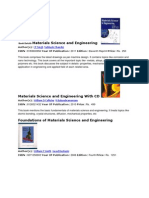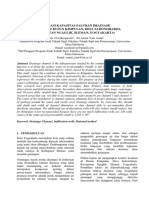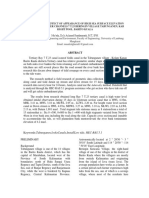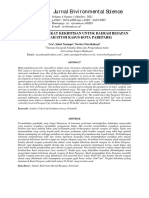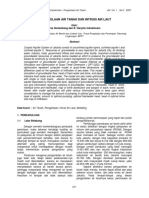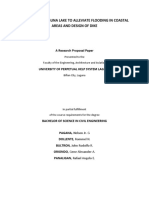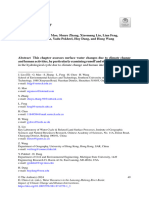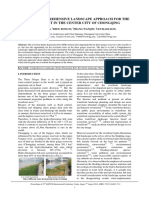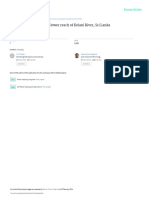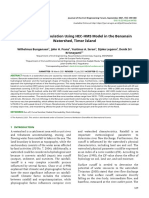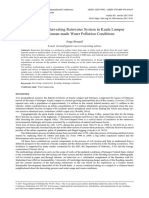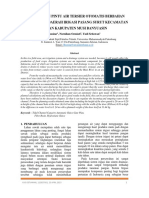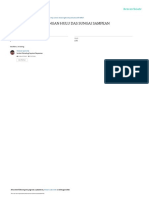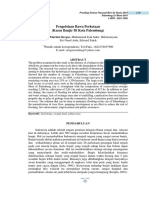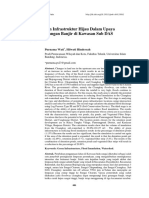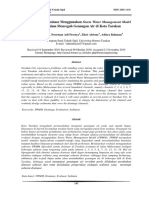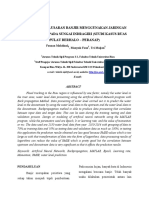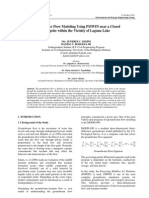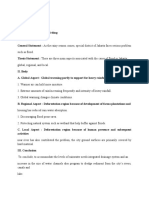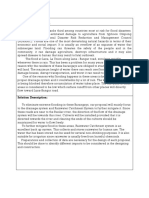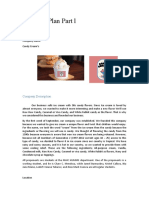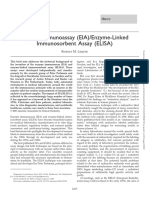Jurnal Drainase 3
Jurnal Drainase 3
Uploaded by
Denida Oktavia HCopyright:
Available Formats
Jurnal Drainase 3
Jurnal Drainase 3
Uploaded by
Denida Oktavia HCopyright
Available Formats
Share this document
Did you find this document useful?
Is this content inappropriate?
Copyright:
Available Formats
Jurnal Drainase 3
Jurnal Drainase 3
Uploaded by
Denida Oktavia HCopyright:
Available Formats
Makara J. Technol.
21/2 (2017), 83-92
doi: 10.7454/mst.v21i2.3085
Urban Drainage Management and Flood Control Improvement Using the
Duflow Case Study: Aur Sub Catchment, Palembang, South Sumatra, Indonesia
Charlotte de Fraiture1, Robiyanto Hendro Susanto2, F.X. Suryadi1,
and Harrini Mutiara Hapsari Wahyu3*
1. Department of Land and Water Development, Water Science and Engineering, UNESCO IHE,
Westvest 7 2611 AX Delft, The Netherlands
2. Integrated River Lowland Coastal Development Management and Planning, Double Degree Program Pengelolaan
Lingkungan, Universitas Sriwijaya, Palembang 30139, Indonesia
3. Department of Architecture Engineering, Faculty of Engineering, Universitas Sriwijaya, Palembang 30128, Indonesia
*
e-mail: harrinihapsari@gmail.com
Abstract
Urban flooding often times staggers the livelihood in an urban area, which most likely happens in the lowland urban
area. Therefore, the existing urban drainage system should be improved in order to tackle the upcoming urban flooding
events, which are more than likely to be more devastating than those in the previous years. The research location is in
Palembang, Sumatra, Indonesia, where 30% of its urban part is a lowland area. The selected Aur Sub Catchment is
located in Silaberanti. The main objective of this research is to improve the current drainage system in order to achieve
the optimal design for urban drainage arrangement. This research was developed using Duflow Modelling Studio 3.8.3 in
collaboration with ArcGIS 10.1 to schematize the drainage system and analyse the spatial and topographical condition
of the research area. As a result, there are three development scenarios established by Duflow Modelling Studio in order
to improve the drainage system in the research area. The first scenario is the current and extreme condition in the study
area. The second scenario is the extreme condition, which is represented by the extreme rainfall. The third scenario is
the improvement possibilities of the existing drainage system. There are three different types of improvements and
modifications for the third scenario which are: canal dredging, canal dike/embankment, a pump installation, and a flap gate
installation. In conclusion, based on three different scenario analyses, the most feasible, suitable, effective, and efficient
alternative for overcoming the flooding in Silaberanti is a flap gate installation combined with dike construction in the
flood risk sections of the river because it works automatically depending on the water level in the River.
Abstrak
Pengelolaan Drainase Daerah Perkotaan dan Perbaikan Pengendalian Banjir Menggunakan Studi Kasus
Duflow: Sub-Daerah Tangkapan Air Aur, Palembang, Sumatra Selatan, Indonesia. Banjir di daerah perkotaan
sering kali mengganggu laju penghidupan di daerah perkotaan, dan cenderung terjadi di daerah perkotaan dengan
dataran rendah. Oleh karena itu, sistem drainase perkotaan yang ada harus ditingkatkan kualitasnya untuk mengatasi
kejadian banjir perkotaan yang akan datang, yang kemungkinan besar efeknya akan lebih buruk daripada di tahun-tahun
sebelumnya. Lokasi penelitian makalah ini adalah Palembang, Sumatra, Indonesia, dimana 30% daerah perkotaannya
terdiri dari daerah dataran rendah. Sub-daerah tangkapan air Aur yang dipilih terletak di Silaberanti. Tujuan utama dari
penelitian ini adalah untuk memperbaiki sistem drainase yang ada agar dapat mencapai desain optimal untuk pengaturan
drainase perkotaan. Penelitian ini dikembangkan dengan menggunakan Duflow Modeling Studio 3.8.3 dan ArcGIS 10.1
untuk merancang sistem drainase dan menganalisis kondisi spasial dan topografi kawasan penelitian. Sebagai hasilnya,
ada tiga skenario pembangunan yang dibuat oleh Duflow Modeling Studio untuk memperbaiki sistem drainase di
daerah penelitian. Skenario pertama adalah kondisi saat ini dan kondisi ekstrem di wilayah studi. Skenario kedua adalah
kondisi ekstrem, yang diwakili oleh curah hujan yang sangat tinggi. Skenario ketiga adalah kemungkinan perbaikan
sistem drainase yang ada. Ada tiga jenis perbaikan dan modifikasi untuk skenario ketiga, yaitu: pengerukan kanal,
konstruksi tanggul kanal, instalasi pompa, dan instalasi pintu flap. Makalah ini menyimpulkan, berdasarkan tiga analisis
skenario yang berbeda, bahwa alternatif yang paling layak, cocok, efektif, dan efisien untuk mengatasi banjir di
Silaberanti adalah instalasi pintu flap yang digabungkan dengan konstruksi tanggul di bagian-bagian sungai yang
berisiko banjir karena pintu flap dapat bekerja secara otomatis tergantung pada permukaan air sungai.
Keywords: DUFLOW, drainage system, inundation, urban drainage, urban flooding
83 August 2017 Vol. 21 No. 2
84 de Fraiture et al.
1. Introduction space, catchment area, and the swamp area. It is becoming
a big problem during the rainy and a high tide seasons.
Palembang is situated in the lowland area in the southern Because the capacity of the catchment area for restoring
part of Sumatra Island. A large river, called The Musi water has decreased, inundation happens. Moreover, land
River, divides Palembang into two areas; Seberang Ilir use changes in the upstream part lead to the accumulation
and Seberang Ulu. The city has been growing rapidly in of sediments in the downstream. Furthermore, there are
the past decade due to transmigration and urbanization. some buildings,
ldings, which are mainly for settlement, situated
Most of the trans-migrants come from outside of South in some parts of the body of the river. These buildings are
Sumatra as well as the rural residents who moved to the adversely affecting the drainage system in their ability
urban areas. Currently, the total population of Palembang to carry water.
is about 1.7 million people with a population density of
4,800 people per km2. Secondly, urban drainage condition in this area is still
suffering from a lack of maintenance. The current
Palembang has a total area of 40,610 ha, a, whereas 11,750 condition of the system is not working well enough for
ha is the lowland area. It can be argued that approxi-approxi tackling and maintaining the drainage for the whole
mately 30% of the total area of Palembang
Palemba is relatively area. Even though the drainage systems in some parts of
flat (Figure 1). As a result of being located in the relatively Palembang are already adequate enough, they are not
flat area where the large river flows, flooding is one of yet integrated. That condition means that the overall
many problems
roblems that this city has often faced. Flooding urban drainage system in Palembang is not working as
in the urban areas of Palembang happens once a year, expected. However, it is also common to see the physical
especially during the rainy season in the period of October damage of drainage structurere in some parts of Palembang
to April. area due to the lack of regular maintenance.
There are several factors that lead to the problem of Thirdly, human activities, such as littering the river with
urban flooding in Palembang. First is the change of land either solid or liquid waste, is very harmful to the water
use/which
which has led to a decrease in areas of green open flow. Some people still lack the awareness about the
Figure 1. Map of Palembang
Makara J. Technol. August 2017 Vol. 21 No. 2
Improvement of Urban Drainage and Flood Control in Palembang 85
damage of waste disposal. For example, some households Secondary Data, and Additional Data. The description
still throw their disposal directly to the river, and some about the data and the source of the data are shown in
industries throw their industrial waste to the river without Table 1.
being previously treated. The existence of solid waste in
the body of the river decreases its capacity to carry water In this study, ArcGIS and Duflow (Dutch Flow) were
and, eventually, will cause inundation in the surrounding used in combination to produce the final result of the
area. integrated design for the improvement of the urban
drainage system in Silaberanti area. However, the liability
This research aims to study about the drainage system in of the available data and the competency of the model
Palembang city, particularly in the District of Seberang Ulu play an important role in running and simulating the
I area where this study was carried out. This integrated scenario which is going to be developed.
study of urban water management and flood protection is
crucial for supporting further drainage system development First of all, the catchment delineation process was done
and improvement in Palembang City. for interpreting the sub catchment of the study area with
ArcGIS. Catchment delineation analysis was processed
2. Materials and Methods with the hydrology tools in the spatial analyst. When the
delineated catchment was derived from the analysis, the
There were four main steps taken to achieve the objectives next steps to do were analysing and interpreting the
of the research: Preliminary Stage, Data Acquisition and results. In these steps, the most crucial part was the
Collection Stage, Data Analysis, and Modelling Develop- stream link order and the sub catchment for the stream
ment. The methodology of this study is shown in Figure 2. which was represented the study area. Second of all, the
topographical analysis was done with ArcGIS.
There were two key steps during the preliminary stage
which were essential for the following steps. Those steps Duflow is a computer program to model steady-state
were the arrangement phase for the field survey and the and transient surface water systems (STOWA, 2000).
literature review for the fundamental theory to deepen Duflow consists of a one-dimensional network which is
the knowledge and information about the research. inter-connected with nodes and sections. Hydraulic
structures can be added in the network to get to know
The arrangement for the field survey was done as the the hydraulic performance, such as pump, weir, gate, etc.
guide for the data collection in the field. In this stage, Specifically for this research, one of the main problems
the schedule for data acquisition had been arranged. For of flooding in this area is the lack of maintenance of
instance, what kind of essential field data that was drainage infra-structure and solid waste disposal. The
needed for this study, what kind of measurement that scenarios which were based on the analysis were
needed to be done, how to get the data in the field, and divided into three parts: widening the canals, dredging
the estimated time to know how long the data would be the canals, and the installation of hydraulic structures.
completely developed. The flowchart of ArcGIS and Duflow is presented in
Figure 3.
The literature review examines the urban drainage,
urban flooding, urban polder system, and modelling Table 1. Sources and Detail for Data Acquisition
develo-pment for the study. This stage was done at the
same time with the filed survey arrangement. Any Type Detail Source
activities during the field work were done based on the Primary Data Hydraulic Data In situ field measurement
understanding from the literature review.
Secondary Spatial Data Urban Planning and
Modelling systems used for this study were ArcGIS and Data Hydrological Development Board
DUFLOW. ArcGIS was used for analysing the spatial Data Meteorology, Climato-
data. Meanwhile, DUFLOW was used for the Tidal Fluctua- logy, and Geo-physics
simulation of the suitable scenarios derived from the
tion Data Agency of Palembang
hydrological data of the study area. In addition,
supplementary reading was essential for supporting the USGS Data for City in Kenten Class I
basic theory that had been developed from the literature GIS Modelling Observation Station
review. Supplementary reading included the revision Indonesia Navy
from the previous MSc theses, journals publications,
books, articles, and more. http://earthexplorer.usgs.
gov/
In the data acquisition phase, there were several types of Additional Interview In situ interview
data that had to be collected. Those data could be Discussion
Data
categorized into three different types: Primary Data,
Makara J. Technol. August 2017 Vol. 21 No. 2
86 de Fraiture et al.
Figure 2. Research Methodology Flowchart
Figure 3. Flowchart of ArcGIS and DUFLOW Modelling Development
Makara J. Technol. August 2017 Vol. 21 No. 2
Improvement of Urban Drainage and Flood Control in Palembang 87
3. Results and Discussion
Spatial Data Analysis: Catchment Delineation and
Topography Analysis. The main aim of catchment
delineation is to determine the exact area of the watershed
for the study area including the sub watersheds which
surround it. There were several steps for delineating the
catchment using the spatial analyst tool in ArcGIS. First
of all, the DEM Data which had been retrieved
retri online
from the USGS website needed to be prepared in the
ArcMap. Then, the raster image, which had ha been pro-
jected, was evaluated with several tools in the hydrology
tools from spatial analysts,, such as flow direction, sink,
fill, flow accumulation, stream link, stream order, stream
to feature, basin, snap pour point, basin, and watershed.
The result of catchment delineation surrounding the
study area is represented in Figure 4. Figure 5. Aur Sub Catchment
Figure 4 shows the specific sub catchment for the
research study. This map was derived by determining
the stream link of the Aur River as the area of study. As a
result, the sub catchment of the Aur River in detail can be
determined from the map of the catchment surrounding
the research area. Meanwhile, Figure 5 shows the stream
stre
link of the research area which is indicated by the blue
line. The stream link represents the river to be developed
in advance for this research. This stream link represents
the condition of the Aur River, which is the study area
for the main river studied in this research.
Topography analysis determined the height of the study
area above the mean sea level. In general, Palembang lies
in the low contour zone, approximately 0–8 0 m above the
mean sea level. In the topography analysis, the divisions Figure 6. Contour Map of Palembang
of the contour line for each district in Palembang will be
determined. Digital elevation model (DEM) was used
for the topography analysis of this research. By using
the SRTM data, which havd previously been analysed
for the catchment delineation, the topographical
graphical condition
of Palembang could be determined.
Figure 7. Contour Map of Aur Sub Catchment
The contour interval of 10 m was chosen for this
analysis in order to define the contours with greater
Figure 4. Map of Catchments Surrounding the Research detail and accuratey.. The result of the topographical
Area analysis of Palembang is shown in Figure 6.
Makara J. Technol. August 2017 Vol. 21 No. 2
88 de Fraiture et al.
The highest elevations, indicated with the yellow Furthermore, based on the value of the extreme rainfall
colour, are mostly located in the North-West area of prediction for each distribution, the goodness of fit test
Palembang. On the other hand, the lowest elevations, calculation is presented in Table 4.
specified with the green colour, are located in the
Southern and Eastern parts of the urban area. Table 4. The Goodness of Fit Test: Smirnov – Kolmogorov
Furthermore, the specific contour map of the research
area of Silaberanti sub district or Aur sub catchment can Difference of Critical value
be determined from the contour map of Palembang city Number of Data Gumbel Log Pearson
(n) Normal
by clipping the map with the shapefile of the sub Distribution
Type I Type III
catchment area. The result of the contour map for the Distribution Distribution
study area is shown in Figure 7. 1 14.68 -5.56 20.24
2 8.04 -6.25 14.30
Silaberanti, which is the study area of the research, is 3 -0.21 -9.66 9.44
located in the lower part of Palembang. It can be clearly 4 -0.04 -5.17 5.13
seen that the range of topography elevation in Aur sub 5 -0.22 -4.60 4.38
catchment is from 0 m+MSL to 5 m+MSL. The area 6 0.52 -2.57 3.09
which is closer to the stream has a lower elevation than
7 -1.52 -3.10 1.58
the area which is located farther downstream. The
descriptions for the elevation of the area in Silaberanti 8 23.95 23.94 0.01
can be found in Table 2. 9 26.16 26.68 -0.52
10 27.93 29.16 -1.23
Hydrological Data Analysis: Rainfall Analysis. There 11 0.03 1.65 -1.62
were three general methods of the distribution analysis 12 -0.57 1.58 -2.14
of the rainfall used in this research, namely Normal 13 -2.14 0.67 -2.81
Distribution, Gumbel Type I Distribution, and Log- 14 0.03 2.45 -2.42
Pearson Type III Distribution. The comparison between 15 12.48 15.24 -2.76
those three methods for extreme rainfall prediction with 16 1.95 5.15 -3.20
the return period T is presented in Table 3.
17 1.87 5.00 -3.13
18 2.00 5.18 -3.19
Table 2. Elevation in Aur Sub Catchment
19 0.37 3.72 -3.36
Elevation Total Area 20 -2.40 1.22 -3.62
No
(m+MSL) (ha) 21 -1.71 1.69 -3.40
1 0-1 0.12 22 -1.18 2.13 -3.31
2 1-2 15
23 -1.08 2.25 -3.33
3 2-3 39
4 3-4 40 24 -0.56 2.95 -3.51
5 4-5 1 25 4.69 8.35 -3.67
TOTAL 95.12 26 0.91 3.75 -2.84
27 0.21 2.95 -2.74
28 -0.24 2.56 -2.80
Table 3. Probability Distribution of Normal, Gumbel
Type I, and Log Pearson Type III for Design 29 -0.91 2.00 -2.90
Rainfall 30 -0.73 1.46 -2.19
31 -0.76 0.96 -1.72
Frequency Analyses for Design Rainfall (mm)
32 0.24 1.52 -1.28
Return Log Pearson
Normal Gumbel Type I 33 0.03 0.16 -0.13
Period/ Type III
Tr Distribution Distribution 34 1.65 0.90 0.75
Distribution
(Years) 35 1.12 -0.21 1.33
(mm) (mm) (mm)
36 -0.66 -2.32 1.66
2 0.00 113.40 0.37 109.78 0.08 112.83 37 -15.58 -10.70 -4.88
5 0.84 133.05 1.50 133.06 0.86 133.30 38 -4.04 -8.71 4.67
10 1.28 143.34 2.25 148.47 1.22 144.15 39 0.79 -9.44 10.22
20 1.52 148.96 2.97 163.25 1.36 148.65
Max. Difference 27.93 10.70 46.89
25 1.64 151.76 3.20 167.94 1.58 155.67
Critical value 5% 23.75 35.58 25.50
50 2.05 161.35 3.90 182.39 1.79 162.88
100 2.33 167.90 4.60 196.73 1.98 169.58 Fit test correlation rejected accepted rejected
Makara J. Technol. August 2017 Vol. 21 No. 2
Improvement of Urban Drainage and Flood Control in Palembang 89
From the table, we can conclude that the Gumbel Type I during that day functioned as the input as well as the
Distribution could be accepted, according to the lowest rainfall data. Based on the rainfall data series, the
value of the maximum differences (∆max).
∆max). Therefore, rainfall during the day of the simulation was 28.75
the result of Gumbel Type I Distribution was used for mm/day for one hour. The simulation day was the day
the calculation of maximum daily rainfall
rainfa with the with the highest rainfall andd tides during the wet season.
return period T. The highest rainfall intensity was 202.8
mm/hour a return period of 100 years and duration of 5 Scenario 2: Extreme Conditions. The extreme designed
minutes. On the other hand, the lowest rainfall intensity rainfall with the return periods
period of 25 years and 50 years
was 4.08 mm/hour with a return period of 2 years and was chosen for an extreme condition simulation. For the
duration of one day. The Intensity – Duration – Frequency return period of 25 years, the designed rainfall was
(IDF) Curve based on the table above is presented in 98.58 mm/day for 60 minutes. Meanwhile, the designed
Figure 8. rainfall for the return period of 50 years was 104.53
mm/day for 60 minutes. The water depth of flooding
Modelling Analysis: River Schematization. The schema- between NOD29 and NOD35 was approximately 0.40–
tization of the Aur River was done with the Duflow 0.86 m and after dredging it reduced to around 0.27–
0.2
Modelling Studio which built up a channel network with 0.71 m. The water level during flooding after canal
44 nodes and was connected with sections. The starting dredging could decrease by up to 0.14 m. However, the
point of this schematization is in the downstream part,
part inundation still happened in the risky sections of the
which is the Musi River (SEC MUSI 1, NOD1),
NOD1) and the Aur River.
ending point is the upstream part of the Aur River (SEC
P27+11 – 00+1361B,
0+1361B, NOD35). However, the Aur River
starts where SEC P2 – 00+42A, NOD3 is situated,
situated as
shown in Figure 9.
Scenario 1: Existing Condition.. For the existing condi-
cond
tion, the simulation was affected by the tidal intrusion
with the highest rainfall during the rainy season in 2015.
The scenario of the existing condition used a one-day
simulation. In this simulation, the data for tidal intrusion
Figure 8. IDF (Intensity - Duration - Frequency) Curve
from the Van Breen's Method
Figure 9. Aur River Schematization
Figure 10. Result Comparison of the Analyses
Makara J. Technol. August 2017 Vol. 21 No. 2
90 de Fraiture et al.
the disturbance of the water flow in the canal, such as
solid waste and aquatic vegetation. Furthermore,
building a dike along the canal could be one possible
solution for protecting this area from flooding.
Therefore, development of a dike was implemented for
the scenario with the Duflow Modelling Studio. This
scenario consists of two different types of dike
construction for the system. Lastly, pumps could be
used to control the water level in certain depressed areas
of a channel to reduce the risk of inundation. For this
scenario, a pump with a capacity of 12 m3/s was
installed in the downstream part of Aur River, where the
water level was influenced by tidal fluctuation. The
result comparison between those scenarios is shown in
Figure 10 and Figure 11.
4. Conclusions and Recommendations
There are several conclusions drawn from the analyses
and discussions for the improvement of the urban drainage
system in Silaberanti, South Sumatra, Indonesia. These
conclusions also answer the earlier research questions.
The conclusions are as follows: (a) The main causes of
flooding in Silaberanti area are from the tidal intrusion
from the Musi River to the Aur River system, the high
intensity of the rainfall during a wet season, the existing
condition of the drainage system which is quite inade-
quate to accommodate the existing condition, the flat
topographical condition of the research area, and the
changes in land use due to urbanization; (b) The
existing condition of urban drainage in Silaberanti is not
well maintained and cannot prevent the problem of
flooding in a proper way. There are a lot of solid waste
disposal and aquatic vegetation in the canal which block
the flow of water. In addition, the conveyance capacity
and the dimension of the river are not appropriate for
the drainage system in this area. Thus, the drainage
system needs to be improved; (c) Technical approaches
for coping with the flooding in Silaberanti area are
going to be implemented based on the result of the
modelling analysis. Technical approaches include canal
dredging, canal dike/embankment, a pump installation,
and a flap gate installation; (d) Canal dredging is not
recommended for the urban drainage improvement in
Silaberanti because it only reduces the water level
during flooding by 0.1 m. Furthermore, the inundation
in some stressed sections in Aur River is still likely to
happen in the future; (e) Dike construction alongside the
Aur River is one of the feasible possibilities. A 1 m dike
construction can reduce the inundation rate during the
flooding event, especially in the sections which are in the
high flood risk area; (f) A pump installation provides a
Figure 11. Comparison of the Flooding Areas better result than the previous scenarios. After the
installation of a pump with a capacity of 12 m3/s in the
Scenario 3: Improvement Possibilities of the Existing downstream area of Aur River, the inundations in the
Drainage System. For this scenario, 1 m dredging was risky sections disappeared. However, a pump installation
applied for the whole system. Besides the dredging, the requires a high cost for implementation and operation;
roughness coefficient of the canal increased by cleaning (g) The most recommended drainage system improve-
Makara J. Technol. August 2017 Vol. 21 No. 2
Improvement of Urban Drainage and Flood Control in Palembang 91
ment is a flap gate installation. It is the most feasible [6] G. Belaud, X. Litrico, B. De Graaf, J.P. Baume, J.
enhancement for the urban drainage system in this area. Irrig. Drain. Eng. 134/3 (2008) 315.
The considerations include the low cost, effectiveness, [7] F. Bertolo, Catchment Delineation and Characteri-
and efficiency of the implementation, operation, and sation. Space Application Institute, Joint Research
maintenance; (h) Practical approaches, such as the Centre Ispra (Va), Italy, 2000.
implementation of the concept “Living with Water”, can [8] C.M. Burt, R. Angold, M. Lehmkuhl, S. Styles, J.
help the future development in Silaberanti. For example, Irrig. Drain. Eng. 127 (2001) 84.
by applying the construction of houses which are resilient [9] D. Butler, J.W. Davies, Urban Drainage, 2nd ed.,
for flooding condition, such as Rumah Rakit (Floating Spon Press, London, 2004.
Houses) and Rumah Panggung (Elevated Houses). In [10] K. Chinnayakanahalli, R. Hill, J. Olson, C. Kore-
addition, the revision of governmental urban policies ber, D.G. Tarboton, C. Hwakins, Multi-Watershed
needs to be taken into account for the upcoming of Regional Watershed Analyses. Utah State Uni-
improvement. versity, Utah, 2006.
[11] P. de Laat, Workshop on Hydrology. UNESCO-
A number of recommendations can be derived from IHE Institue for Water Education - WSE Dept,
several analyses in this study for improving the urban Netherlands, 2014.
drainage system in Silaberanti, which are: (a) The Ministry [12] P. de Laat, H. Savenije, Hydrology. UNESCO-IHE
of Public Works of Palembang City should consider the Institue for Water Education - WSE Dept, Nether-
future extreme condition for the improvement of the lands, Lecture Note, 2014.
urban drainage system in Silaberanti. For instance, the [13] EDS, Duflow Manual. EDS, Delft, 1995.
urban drainage designs for 100 years return period [14] F. Federal Emergency Management Agency, FE-
should include a larger catchment area, climate change, MA.gov, https://www.fema.gov/pdf/floodplain/nfip
sea level rise, and urban land use changes; (b) The _sg_unit_1.pdf, 2015.
Palembang City Government, particularly the Urban [15] Gustini, E. (2009). Palembang Urban Drainage and
Planning and Development Board and Ministry of Flood Protection Development. Delft: UNESCO-IHE.
Public Works, should provide the actual and reliable data [16] C.T. Haan, B.J. Barfield, J.C. Hayes, Design Hy-
of the measured urban drainage system in Palembang so drology and Sedimentology for Small Catchments,
that it is not difficult to acquire the data when they are Academic Press, San Diego, California, 1994.
needed for another scientific research in the future; [17] D. Haase, Environ. Impact. Assess. Rev. 29/4
(c) Further systematic approaches, such as Cost Benefit (2009) 211.
Analysis and Cost Estimation Analysis, should be taken [18] H. Hidayat, Konteks Ekologi Kota Tepian Sungai
into account for further research. Cost Benefit analysis dalam Perspektif Lokalitas Bahan Bangunan, Ar-
can be used to decide the most feasible project between chitecture Event, 2014.
several projects. Meanwhile, Cost Estimation Analysis [19] L. ITB, L. Final Report of the Masterplan Drainage
aims to provide the budget estimations or a funding System in Palembang, 2004.
requirement of a project; (d) The Palembang City [20] R.J. Kodoatie, Rekayasa dan Manajemen Banjir
Government needs to be stricter in granting a permit for Kota: Penerbit ANDI, Yogyakarta, 2013.
building settlement along the canal or river, specifically [21] Lazuardi. Urban Drainage System and Flood Pro-
in Silaberanti area, in order to prevent illegal housing. tection in Palembang City. UNESCO-IHE, Delft,
Illegal housing causes land use to change from flood 2014.
prone areas to residential areas and increase the rate of [22] R.H. McCuen, (1989). Hydrology Analysis and
flooding. Design. Prentice Hall, Inc., Englewood Cliffs, New
Jersey 07632, 1989.
References [23] Mujumdar, P. Stochastic Hydrology, Department
of Civil Engineering: Indian Institute of Science,
[1] P. Ankum, Design of Open-Channels and Hydrau- Lecture Note, n.d.
lic Structures,. Faculteit Civiele Techniek en Geo- [24] U.P. Palembang, Rencana Tata Bangun Lahan
wetenschappen, Netherland, Lecture Notes, 2002. (RTBL).Urban Planning and Development Board
[2] R. Ashley, S. Garvin, E. Pasche, A. Vassilopoulus, of Palembang (BAPPEDA), Palembang, 2008.
C. Zevenbergen, Advances in Urban Flood Ma- [25] U.P. Palembang, Palembang in Figure 2014. Urban
nagement, Taylor & Francais, London, UK, 2007. Planning and Development Board of Palembang
[3] O.B Azeez, F.J. Ayoola, Eur. J. Health. Econ. 4/17 (BAPPEDA), Palembang, 2014.
(2013) 94. [26] J. Parkinson, O. Mark, Urban Stormwater Mana-
[4] A. Badawy, H. Abdel-Salam, H. Ayad, AEJ. 54 gement in Developing Countries. Gray Publishing,
(2015) 1225. Turnbridge Wells, UK, 2005.
[5] P.B. Bedient, W.C. Huber, B.E. Vieux, Hydrology [27] P. Paron, Introduction to GIS and Remote Sensing-
and Floodplain Analysis, 4th ed., Pearson Interna- Guided Exercise. Water Science and Engineering
tional Edition, Upper Sadder River, NJ 07458, 2008. Department - Unesco IHE, Netherlands, 2014.
Makara J. Technol. August 2017 Vol. 21 No. 2
92 de Fraiture et al.
[28] D. Purnomo, Urban Drainage Evaluation and [34] Stowa/MX.Systems, Duflow Modelling Studio,
Flood Mitigation Measures Case Study: Lambidaro User's Guide. 2006 (February).
River Palembang City. UNESCO-IHE, Delft, 2013. [35] Suripin, Sustainable Urban Drainage System. Andi
[29] T.Y. Puspita, Public Preference for Flood Risk Offset, Yogyakarta, 2004 [In Indonesian].
Reduction: Case Study of Bendung Sub-Basin, [36] C.E. Tucci, Urban Drainage in Specific Climates:
Palembang City, South Sumatra, Indonesia. Urban Drainage in Humid Tropic. International
UNESCO-IHE, Delft, 2014. Hydrological Programme, Paris, 2001.
[30] H.P. Ritzema, Drainage Principle and Application. [37] S.G. Walesh, Urban Surface Water Management,
International Institute for Land Reclamation and 1st ed.,Wiley-Interscience, New York, 1989.
Improvement, Wageningen, 1994. [38] M.O. Works, Panduan dan Petunjuk Praktis Penge-
[31] L. Schmocker, Hydraulics of Dike Breaching. lolaan Drainase Perkotaan. Jakarta, 2003 [In Indo-
Université Catholique de Louvain, Belgium, 2011. nesian].
[32] F.J. Smits, C.J. Hemker, Modelling The Interaction [39] W.Y. Yuan, A. Shaker, N. El-Ashmawy, Urban land
of Surface-water and Groundwater Flow by Linking cover classification using airborne LiDAR data: A
Duflow to MicroFem, FEM_MODFLOW, Karlovy review, 2014.
Vary, Czech Republic, 2004. [40] C. Zevenbergen, A. Cashman, N. Evelpidou, E.
[33] Stowa/MS.Systems, Duflow Modelling Studio, Pasche, S. Garvin, R. Ashley, Urban Flood Manage-
Duflow Manual, 2004 (August). ment. Taylor & Francais Group, London, UK, 2011.
Makara J. Technol. August 2017 Vol. 21 No. 2
You might also like
- Book Details Materials Science and EngineeringDocument3 pagesBook Details Materials Science and EngineeringAakanshaVGNo ratings yet
- Retaining WallDocument1 pageRetaining WalljemtanNo ratings yet
- 08 Naskah PublikasiDocument10 pages08 Naskah PublikasiAlex KesumaNo ratings yet
- Tertiary Ray 7 T.23 Canal Isoneof Fields Canal in The Tabunganen Village, Kolam KananDocument19 pagesTertiary Ray 7 T.23 Canal Isoneof Fields Canal in The Tabunganen Village, Kolam KananIlyas KpaNo ratings yet
- 1144 1412 1 SMDocument7 pages1144 1412 1 SMGabriel Julessio TbnNo ratings yet
- Garuda 1510015Document11 pagesGaruda 1510015Deni haryadiNo ratings yet
- Jurnal Environmental Scienc: Pemetaan Tingkat Kekritisan Untuk Daerah Resapan (Wilayah Studi Kasus Kota Parepare)Document14 pagesJurnal Environmental Scienc: Pemetaan Tingkat Kekritisan Untuk Daerah Resapan (Wilayah Studi Kasus Kota Parepare)adintNo ratings yet
- 2348 4120 1 SM PDFDocument15 pages2348 4120 1 SM PDFjanuarNo ratings yet
- PBL Ce5813Document7 pagesPBL Ce5813Rohit AdhikariNo ratings yet
- FloodDocument6 pagesFloodnazoNo ratings yet
- Dredging of Laguna Lake To Alleviate Flooding in Coastal Areas and Design of DikeDocument3 pagesDredging of Laguna Lake To Alleviate Flooding in Coastal Areas and Design of DikeJohn Rodolfo BultronNo ratings yet
- Experimental Model of Dam Break Flow Around Several Blockages ConfigurationsDocument7 pagesExperimental Model of Dam Break Flow Around Several Blockages ConfigurationsMohammad FaridNo ratings yet
- A Sustainable Drainage System Design in Water-Stricken Brgy. 82 Marasbaras-Villa Dolina Subdivision, Tacloban CityDocument5 pagesA Sustainable Drainage System Design in Water-Stricken Brgy. 82 Marasbaras-Villa Dolina Subdivision, Tacloban CityJeffrey BeloyNo ratings yet
- Spesifikasi Teknis Bangunan GeDocument10 pagesSpesifikasi Teknis Bangunan GeDedy RizkiyadiNo ratings yet
- Iaeg 488Document9 pagesIaeg 488DjayusYusNo ratings yet
- Surface WaterDocument71 pagesSurface WaterannycranberryrecruitersNo ratings yet
- River Metamorphosis, NeyyarDocument25 pagesRiver Metamorphosis, NeyyarDr.Thrivikramji.K.P.No ratings yet
- Study On Comprehensive Landscape Approach For The Riverfront in The Center City of ChongqingDocument6 pagesStudy On Comprehensive Landscape Approach For The Riverfront in The Center City of ChongqingyaredgirmaworkuNo ratings yet
- Urban Stormwater Runoff: A New Class of Environmental Flow ProblemDocument11 pagesUrban Stormwater Runoff: A New Class of Environmental Flow ProblemStefanie AngelesNo ratings yet
- Stormwater Quality Malabe ManuscriptDocument7 pagesStormwater Quality Malabe ManuscriptAdhesha FernandoNo ratings yet
- ISERTMN2019 - 013 - Ira Widyastuti - Jumlah Halaman & Sitasi Belum Di PerbaikiDocument14 pagesISERTMN2019 - 013 - Ira Widyastuti - Jumlah Halaman & Sitasi Belum Di PerbaikiRahmad PatarruNo ratings yet
- Flood_hazard_mapping_in_lower_reach_of_Kelani_RiveDocument7 pagesFlood_hazard_mapping_in_lower_reach_of_Kelani_Rives18001897No ratings yet
- Literature Review - RiverDocument12 pagesLiterature Review - Riveruyunaman100% (2)
- Analisa Hidrologi PesanggrahanDocument7 pagesAnalisa Hidrologi PesanggrahanHandaka Darmo DjatiNo ratings yet
- Amin HECRAS 5Document13 pagesAmin HECRAS 5Bintang Hari Yudha ParipurnaNo ratings yet
- Rainfall-Runoff Simulation Using HEC-HMS Model in The Benanain Watershed, Timor IslandDocument10 pagesRainfall-Runoff Simulation Using HEC-HMS Model in The Benanain Watershed, Timor IslandDenik Sri KrisnayantiNo ratings yet
- The Deficient Harvesting Rainwater System in Kuala Lumpur and The Human-Made Water Pollution ConditionsDocument8 pagesThe Deficient Harvesting Rainwater System in Kuala Lumpur and The Human-Made Water Pollution Conditionslokeshkumar_mNo ratings yet
- Bachelor Thesis - Sedimentation Reduction and Check Dam Design in The Cilalawi River (GJVos) - SendDocument92 pagesBachelor Thesis - Sedimentation Reduction and Check Dam Design in The Cilalawi River (GJVos) - SendLauravista Septy FerlanyNo ratings yet
- Water: Impact Analysis of Lakefront Land Use Changes On Lake Area in Wuhan, ChinaDocument18 pagesWater: Impact Analysis of Lakefront Land Use Changes On Lake Area in Wuhan, ChinaImam SyahraniNo ratings yet
- Summary FormatDocument4 pagesSummary FormatKisuke UraharaNo ratings yet
- 7489 16110 1 PB PDFDocument8 pages7489 16110 1 PB PDFRonal ArmandoNo ratings yet
- Jurnal - Yudi SetiawanDocument14 pagesJurnal - Yudi SetiawanYudi SetiawanNo ratings yet
- Sermo Dam ExperienceDocument8 pagesSermo Dam ExperienceVicky Ariyanti WicaksonoNo ratings yet
- POLA ALIRAN BANJIR - Tri SusantiDocument7 pagesPOLA ALIRAN BANJIR - Tri SusantiSukma DharmajatiNo ratings yet
- Studi Potensi Tampungan Hulu Das Sungai Sampean: July 2009Document16 pagesStudi Potensi Tampungan Hulu Das Sungai Sampean: July 2009Deddy Prasetyo UtomoNo ratings yet
- Environmentally Friendly Drainage System (Eco-Drainage) by Harvesting RainwaterDocument9 pagesEnvironmentally Friendly Drainage System (Eco-Drainage) by Harvesting RainwaterAnanda Jelita YusufNo ratings yet
- Jeany Rahma - 30.0339 - J4 - Implementasi Mitigasi Bencana Banjir Melalui Pemanfaatan Kolam Retensi Di Kota Palembang Provinsi Sumatera SelatanDocument11 pagesJeany Rahma - 30.0339 - J4 - Implementasi Mitigasi Bencana Banjir Melalui Pemanfaatan Kolam Retensi Di Kota Palembang Provinsi Sumatera SelatanAkhi DaffaNo ratings yet
- Uts - Aspek Hukum - Zulbahri - F11120119Document15 pagesUts - Aspek Hukum - Zulbahri - F11120119ZulbahriNo ratings yet
- Pengelolaan Rawa Perkotaan (Kasus Banjir Di Kota Palembang) : Sondang Martini Siregar, Muhammad Icuk Sakir, HelmizuryaniDocument7 pagesPengelolaan Rawa Perkotaan (Kasus Banjir Di Kota Palembang) : Sondang Martini Siregar, Muhammad Icuk Sakir, HelmizuryaniputriizzatnNo ratings yet
- 1 PBDocument12 pages1 PBVitus AntonioNo ratings yet
- Study of Network System and Capacity of Bangkala Drainage Channels in 5 MakassarDocument7 pagesStudy of Network System and Capacity of Bangkala Drainage Channels in 5 MakassarInternational Journal of Innovative Science and Research TechnologyNo ratings yet
- 10 1 1 665 957 PDFDocument22 pages10 1 1 665 957 PDFyosua girsangNo ratings yet
- Evaluasi Sistem Drainase Menggunakan Storm Water Management Model (SWMM) Dalam Mencegah Genangan Air Di Kota TarakanDocument12 pagesEvaluasi Sistem Drainase Menggunakan Storm Water Management Model (SWMM) Dalam Mencegah Genangan Air Di Kota TarakanSiti Nur SalsabilaNo ratings yet
- Overview of River Over Drainage Channels in The Wailela River Watershed, Teluk Ambon District, Ambon CityDocument19 pagesOverview of River Over Drainage Channels in The Wailela River Watershed, Teluk Ambon District, Ambon CityIJAERS JOURNALNo ratings yet
- The Assessment of Drainage Performance I fb21b171Document8 pagesThe Assessment of Drainage Performance I fb21b171John Cris CaminongNo ratings yet
- Analisis Penulusaran Banjir Menggunakan Jaringan Saraf Tiruan Pada Sungai IndragiriDocument9 pagesAnalisis Penulusaran Banjir Menggunakan Jaringan Saraf Tiruan Pada Sungai IndragiriMarisya Wahyuna 1607111933No ratings yet
- Jurnal Tentang Pintu Air Fiber ResinDocument15 pagesJurnal Tentang Pintu Air Fiber ResinYudi SetiawanNo ratings yet
- Architectural Shape Optimization of Moving DamDocument14 pagesArchitectural Shape Optimization of Moving Damfatimah.crgunawanNo ratings yet
- The Impact of Using Dam For Flood Control in The Philippines: A Case StudyDocument7 pagesThe Impact of Using Dam For Flood Control in The Philippines: A Case StudyJoshua Miguel BunoNo ratings yet
- An Integrated Simulation Model For Water Management in A Small River Basin: A Case of Tampo River in West Sumatra, IndonesiaDocument11 pagesAn Integrated Simulation Model For Water Management in A Small River Basin: A Case of Tampo River in West Sumatra, IndonesiaRudi FebriamansyahNo ratings yet
- ThesisDocument4 pagesThesisdanilorodolfa4631No ratings yet
- Essay ReviseDocument4 pagesEssay ReviseHanifah IndrianaNo ratings yet
- Bocatomas Construidas en El Perú InglesDocument10 pagesBocatomas Construidas en El Perú InglesGianmarcoTarifeñoNo ratings yet
- All My NiggasDocument4 pagesAll My Niggasibganraffy22No ratings yet
- Estimasi Sebaran Daerah Rawan Banjir Bandang Sub Daerah Aliran Sungai Sumber Brantas Kota Batu: Aplikasi Model Genriver & Sistem Informasi GeografiDocument8 pagesEstimasi Sebaran Daerah Rawan Banjir Bandang Sub Daerah Aliran Sungai Sumber Brantas Kota Batu: Aplikasi Model Genriver & Sistem Informasi GeografiKhoirul Anam PrasetiyoNo ratings yet
- Summary Report of Masters ThesisDocument5 pagesSummary Report of Masters ThesisAshenafi WondimuNo ratings yet
- Team Name: Problem StatementDocument3 pagesTeam Name: Problem StatementShania ReyesNo ratings yet
- Water and Environment in the Selenga-Baikal Basin: International Research Cooperation for an Ecoregion of Global RelevanceFrom EverandWater and Environment in the Selenga-Baikal Basin: International Research Cooperation for an Ecoregion of Global RelevanceNo ratings yet
- Sedimentary Crisis at the Global Scale 2: Deltas, A Major Environmental CrisisFrom EverandSedimentary Crisis at the Global Scale 2: Deltas, A Major Environmental CrisisNo ratings yet
- Physical and Chemical Techniques for Discharge Studies - Part 1From EverandPhysical and Chemical Techniques for Discharge Studies - Part 1RB SalamaNo ratings yet
- Seow Koji Takehira 0320816-CompressedDocument23 pagesSeow Koji Takehira 0320816-Compressedapi-302702920No ratings yet
- Neumann KPG - Brochure PDFDocument2 pagesNeumann KPG - Brochure PDFromaoj671No ratings yet
- Sword Art Online Alternative - Gun Gale Online - Volume 01 - Squad JamDocument431 pagesSword Art Online Alternative - Gun Gale Online - Volume 01 - Squad JamasdfsdjhNo ratings yet
- Ultra Petronne Interior Supply Corporation - Boards Price ListDocument1 pageUltra Petronne Interior Supply Corporation - Boards Price ListAlberto Dorupa50% (2)
- White Paper - Saw Filter 2018Document16 pagesWhite Paper - Saw Filter 2018NHẬT BÙI ĐOÀN MINHNo ratings yet
- Fiche Technique FT53027Document1 pageFiche Technique FT53027MateusNo ratings yet
- Designing Finite State Machines (FSM) Using VerilogDocument8 pagesDesigning Finite State Machines (FSM) Using Verilog1am17ec014 ashnal ahmedNo ratings yet
- Condition Monitoring TataDocument24 pagesCondition Monitoring TataNicolas Pérez MoralesNo ratings yet
- Mathematics Paper 1 TZ2 HLDocument19 pagesMathematics Paper 1 TZ2 HLsohamNo ratings yet
- RPL Dfo 1-1 2-2 3-3 Rev 14Document32 pagesRPL Dfo 1-1 2-2 3-3 Rev 14Jesús Gabriel RodríguezNo ratings yet
- CelikDocument3 pagesCeliknikolaNo ratings yet
- Saahas Zero Waste Profile - 2018 PDFDocument25 pagesSaahas Zero Waste Profile - 2018 PDFRashmi PrasadNo ratings yet
- Catalogo Chumaceras Alta Temperatura SKF PDFDocument44 pagesCatalogo Chumaceras Alta Temperatura SKF PDFJhonFerneyBohorquezSaldarriaga100% (1)
- Exercise 14 SolutionsDocument42 pagesExercise 14 SolutionsLancePacioNo ratings yet
- Business Plan Part L, LL & LLLDocument6 pagesBusiness Plan Part L, LL & LLLMaria Theresa Cortez MendozaNo ratings yet
- Clinch em 2415Document4 pagesClinch em 2415Hamza WELGONo ratings yet
- Steel Framing - Grupo 1 - Cristiani, Farall y FernandezDocument16 pagesSteel Framing - Grupo 1 - Cristiani, Farall y FernandezYamila Mariel FarallNo ratings yet
- Adhesive InstructionsDocument3 pagesAdhesive Instructionsyiel2003No ratings yet
- Sri Isopanisad Self StudyDocument16 pagesSri Isopanisad Self StudyKelisha Moodley100% (2)
- PATHFit 1 ACTIVITY SHEETS 2024Document25 pagesPATHFit 1 ACTIVITY SHEETS 2024tubigonivanNo ratings yet
- Efficia CM Series Install Config GuideDocument96 pagesEfficia CM Series Install Config GuideHudson RangelNo ratings yet
- 978-1-58503-738-4 - Autodesk Revit 2013 BIM Management Template and Family Creation - 978-1-58503-738-4-1Document78 pages978-1-58503-738-4 - Autodesk Revit 2013 BIM Management Template and Family Creation - 978-1-58503-738-4-1Mohamed H. JiffryNo ratings yet
- Citel 2CP 202302en Pl24-Cat6Document1 pageCitel 2CP 202302en Pl24-Cat6vish2008 anandNo ratings yet
- The Theosophist Vol 144. No. 1Document44 pagesThe Theosophist Vol 144. No. 1Abraham SolomonNo ratings yet
- TOEFL Written Expression QuestionsDocument40 pagesTOEFL Written Expression QuestionsZain Saputra100% (2)
- The Bitumen Industry - A Global Perspective - March 2011 EditionDocument43 pagesThe Bitumen Industry - A Global Perspective - March 2011 EditionRaluca Dobre100% (1)
- Ielts Reading Test 5Document12 pagesIelts Reading Test 5karzol135% (31)
- 2 - Acute Abdomen in ChildrenDocument66 pages2 - Acute Abdomen in ChildrenAhmed HeshamNo ratings yet
